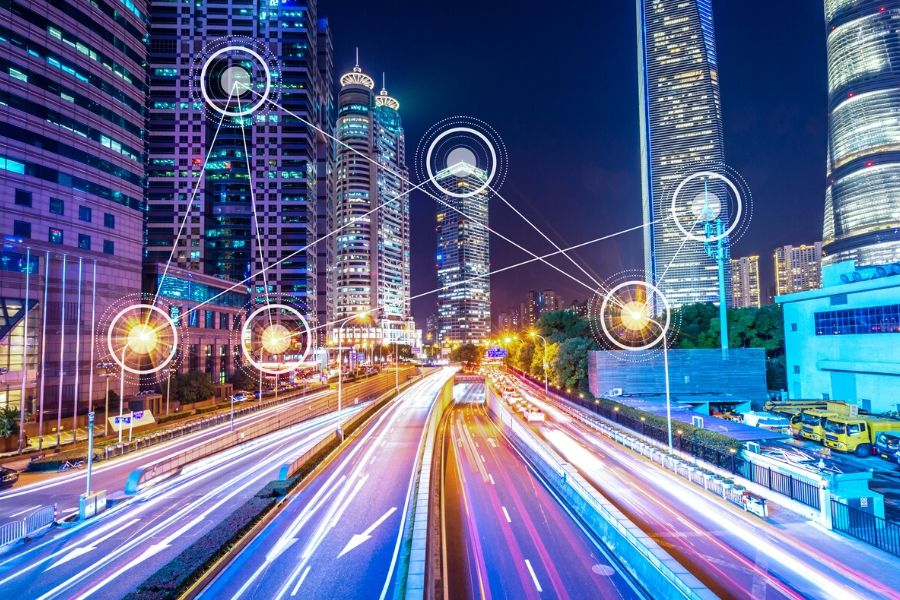Need to speak to us? Here’s our most useful number and email addresses
Sales: sales@heald.uk.com
General information: info@heald.uk.com
Marketing: marketing@heald.uk.com
Need to speak to us? Here’s our most useful number and email addresses
Sales: sales@heald.uk.com
General information: info@heald.uk.com
Marketing: marketing@heald.uk.com

A Smart City is an urban area that uses the integration of artificial intelligence (AI), GPS and the Internet of Things (IoT) to create big data insights, which in turn seeks to better improve operations across a city resulting in less congestion, better air quality and improving safety in real-time.
The global lockdown, as a result of the COVID-19 pandemic, has provided both city planners and citizens with time to think about what they want the world to look like as we emerge into a new normal, and in particular how we do it safely.
While Smart Cities are nothing new, in fact, the approaches have been in existence for over a decade, now is the time to make significant improvements to the way in which we live our daily lives to enhance public safety.
At present approximately 56% of the global population live in urbanised city environments and according to the UN, this is set to increase to 70% by 2050. Such growth means greater pressure on local infrastructure due to commuters and visitors, especially in areas that are being asked to refrain from the use of public transport.
With an estimated 20% reduction in public transport users, according to research via the BBC, it is likely we will see a rise in the number of vehicles on the road alongside an increase in pedestrians and cyclists.
The increase in road users is likely to create significant challenges, resulting in a recipe for disaster without the necessary infrastructure upgrades being put in place to ensure roads can be used safely to reduce the risk of fatalities and injuries both from accidental and intentional threats.
As walking and cycling increases due to the reduction in public transport travel, along with the sight of shoppers queuing outside of stores due to social distancing, it is vital that urban planners are creating protected pedestrianised areas to mitigate the risk of vehicle-based accidents/attacks to allow visitors to feel safe when out in public, and more importantly to ensure those businesses reopening are given the support to increase footfall and enable their businesses to be viable.
With the integration of information and communication technology, these areas can be protected from general vehicle traffic with, for example, automated barriers which provide permitted access for emergency response vehicles and other services, such as deliveries and public transport, by integrating security products with existing CCTV or ANPR systems.
The use of static and automated bollards such as Heald’s sliding bollard, the Matador, or automatic rising bollard, the Evo, to enforce these restrictions provides security to people without restricting the movement of pedestrians and cyclists.
The general public wants to feel safe and have confidence that the security measures in place will protect them and enable them to return to their daily lives. Therefore, for the high streets to recover from this business hiatus, there needs to be a focus on pedestrian security and use of technology to regain the high streets footfall.
The current situation, created by the COVID-19 virus, ongoing protests and riots, heightens the risk of vehicle-based security threats as has already been seen with cars used to attack protestors in the USA. As nations begin to lift lockdowns and we see more people on the streets, it needs to be realised that the threat of hostile vehicle attacks has not gone away.
While the way we go about our daily lives changes in order to reduce the threat of the pandemic, it has led to concerns about the climate emergency, which was high on the agenda prior to the pandemic.
With personal car usage estimated to increase as a result of confidence in using public transport at an all-time low, adopting smart city technology to manage the volume of traffic will be vital, especially when it comes to minimising emissions in an area at any one time.
To help minimise the carbon footprint of implementing traffic control and security measures, Heald has a range of products that operate electro-mechanically reducing the amount of electricity required for use by 60% and completely remove the need for oil to operate, making them the most energy-efficient products on the market, while still providing the highest level of protection from vehicle attacks, ram raids or accidental damage.
To discuss your security requirements with Heald, and how our crash-tested security solutions can be integrated with and support your smart city project, contact our friendly and knowledgeable team today.
Crash tested to a variety of standards, including PAS 68, IWA 14 and ASTM, we design and manufacture a range of security bollards and barriers to help you mitigate the threat of hostile vehicle attacks to ensure the highest standards of public safety.

